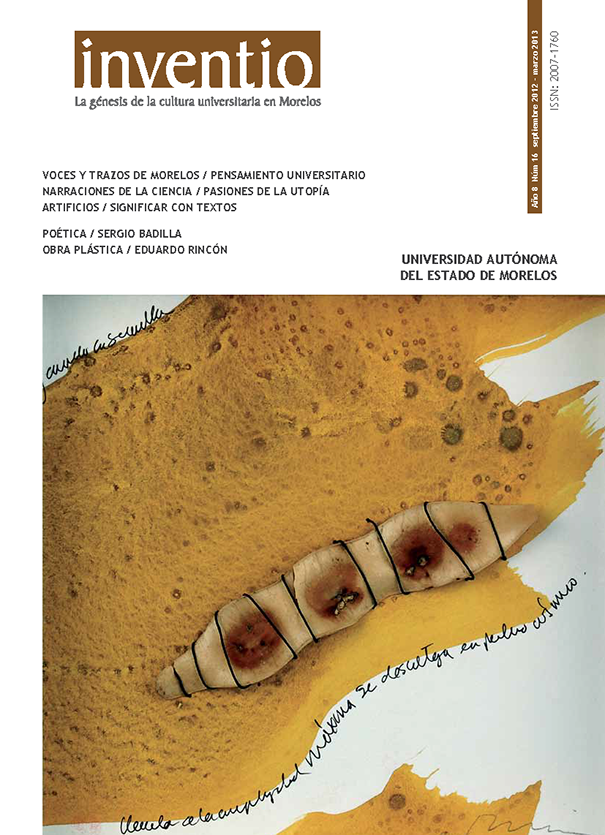Los miR, moléculas con grandes potenciales
Resumen
A partir del estudio del ADN y del ARN, se logró descubrir recientemente el miR o microARN y su relación con algunas enfermedades humanas, como los diferentes tipos de Cáncer, el Alzheirmer y el Parkinson, que probablemente puedan curarse por medio del uso o eliminación del miR adecuado. Existen diferentes plantas que contienen cierto tipo de miR que pueden ser utilizadas en los tratamientos médicos. Esta nueva perspectiva de acercase a las afectaciones humanas abre una posibilidad de conocimiento y de manipulación de la genética; así como una forma de detección de ciertas enfermedades y su posible solución.
Citas
Amy E. Pasquinelli, Brenda J. Reinhart, Franck J. Slack, Mark Q. Martindale, Mitzi I. Kuroda, Betsy Maller, David C. Hayward, Eldon E. Ball, Bernard Degnan, Peter Muller, Jurg Spring, Ashok Srnivasan, Mark Fishman, John Finnerty, Joseph Corbo, Michael Levine, Patrick Leahy, Eric Davidson y Gary Ruvkun, “Conservation of the sequence and temporal expression of let-7 heterochronic regulatory RNA”, Nature, vol. 408, 2000, pp. 86-89.
Anna M. Krichevsky y Galina Gabriely, “miR-21: a small multi-faceted RNA”, Journal of Cellular and Molecular Medicine, vol. 13, 2009, pp. 39-53.
Anne Schaefer, Dónal O’Carroll, Chan Lek Tan, Dean Hillman, Mutsuyuki Sugimori, Rodolfo Llinas y Paul Greengard, “Cerebellar neurodegeneration in the absence of microRNAs”, The Journal of Experimental Medicine, vol. 204, 2007, pp. 1553-1558.
Antony Rodriguez, Sam Griffiths-Jones, Jennifer L. Ashurst y Allan Bradley, “Identification of mammalian microRNA host genes and transcription units”, Genome Research, vol. 14, 2004, pp. 1902-1910.
Brenda J. Reinhart, Frank J. Slack, Micahel Basson, Amy E. Pasquinelli, Jill C. Bettinger, Ann E. Rougvie, H. Robert Horvitz y Gary Ruvkun, “The 21-nucleotide let-7 RNA regulates developmental timing in Caenorhabditis elegans”, Nature, vol. 403, 2000, pp. 901-906.
Ester Saus, Virginia Soria, Geòrgia Escaramís, Francesca Vivarelli, José M Crespo, Birgit Kagerbauer, José Manuel Menchón, Mikel Urretavizcaya, Mònica Gratacòs y Xavier Estivill, “Genetic variants and abnormal processing of premiR-182, a circadian clock modulator, in major depression patients with late insomnia”, Human Molecular Genetics, vol. 19, 2010, pp. 4017-4025.
Giridhar Mudduluru, Jonahunnatha N. George-William, Santoshi Muppala, Irfan a Asangani, Regalla Kumarswamy, Laura D. Nelson et al., “Curcumin regulates miR-21 expression and inhibits invasion and metastasis in colorectal cancer”, Bioscience Reports, vol. 31, 2011, pp. 185-197.
Jacek Krol, Krzysztof Sobczak, Urszula Wilczynska, Maria Drath, Anna Jasinska, Danuta Kaczynska y Wlodzimierz J. Krzyzosiak, “Structural features of microRNA (miRNA) precursors and their relevance to miRNA biogenesis and small interfering RNA/short hairpin RNA design”, The Journal of Biological Chemistry, vol. 279, 2004, pp. 42230-42239.
Jonathan Hollander, Heh-In Im, Antonio L. Amelio, Jannet Kocerha, Purva Bali, Qun Lu, David Willoughby, Claes Wahlestedt, Michael D. Conkright y Paul J Kenny, “Striatal microRNA controls cocaine intake through CREB signalling”, Nature, vol. 466, 2010, pp. 197-202.
Jongpil Kim, Keiichi Inoue, Jennifer Ishii, William B. Vanti, Sergey V. Voronov, Elizabeth Murchison, Gregory Hannon y Asa Abeliovich, “A MicroRNA feedback circuit in midbrain dopamine neurons”, Science, vol. 317, 2007, pp. 1220-1224.
Lin Shi-Lung, Donald Chang y Shao-Yao Ying, “Asymmetry of intronic pre-miRNA structures in functional RISC assembly”, Gene, vol. 356, 2005, pp. 32-38.
Lin Zhang, Hou Dongxia, Chen Xi, Li Donghai, Zhu Lingyun, Zhang Yujung, Li Jing, Bian Zhen, Liang Xiangying, Cai Xing, Yin Yuan et al., “Exogenous plant MIR168a specifically targets mammalian LDLRAP1: evidence of cross-kingdom regulation by microRNA”, Cell Research, vol. 22, 2011, pp. 107-126.
Madhu S. Kumar, Stefan J. Erkeland, Ryan E. Pester, Cindy Y. Chen, Margaret S. Ebert, Phillip A. Sharp y Tyler Jacks, “Suppression of non-small cell lung tumor development by the let-7 microRNA family”, Proceedings of the National Academy of Sciences of the United States of America, vol. 105, 2008, pp. 3903-3908.
Mirko Trajkovski, Jean Hausser, Jürgen Soutschek, Bal Bhat, Akinc Akin, Mihaela Zavolan et al., “MicroRNAs 103 and 107 regulate insulin sensitivity”, Nature, vol. 474, 2011, pp. 649-653.
Pedro Medina, Mona Nolde y Frank J. Slack, “OncomiR addiction in an in vivo model of microRNA-21-induced pre-Bcell lymphoma”, Nature, vol. 467, 2010, pp. 86-90.
Robert E. Lanford, Elisabeth S. Hildebrandt-Eriksen, Andreas Petri, Robert Persson, Morten Lindow, Martin E. Munk et al., “Therapeutic silencing of microRNA-122 in primates with chronic hepatitis C virus infection”, Science, vol. 327, 2010, pp. 198-201.
Rosalind C. Lee, Rhonda L. Feinbaum y Victor Ambros, “The C. elegans heterochronic gene lin-4 encodes small RNAs with antisense complementarity to lin-14”, Cell, vol. 75, 1993, pp. 843-854.
Thomas Thum, Carina Gross, Jan Fiedler, Thomas Fischer, Stephan Kissler, Markus Bussen, Paolo Galuppo et al., “MicroRNA-21 contributes to myocardial disease by stimulating MAP kinase signalling in fibroblasts”, Nature, vol. 456, 2008, pp. 980-984.
Descargas
Publicado
Cómo citar
Número
Sección
Licencia

Esta obra está bajo una licencia internacional Creative Commons Atribución-NoComercial 4.0.
Esta revista proporciona acceso abierto inmediato a su contenido, con base en el principio de ofrecer al público un acceso libre a las investigaciones para contribuir a un mayor intercambio global de conocimientos. Se distribuye bajo una licencia Creative Commons Reconocimiento-NoComercial 4.0 Internacional License.


